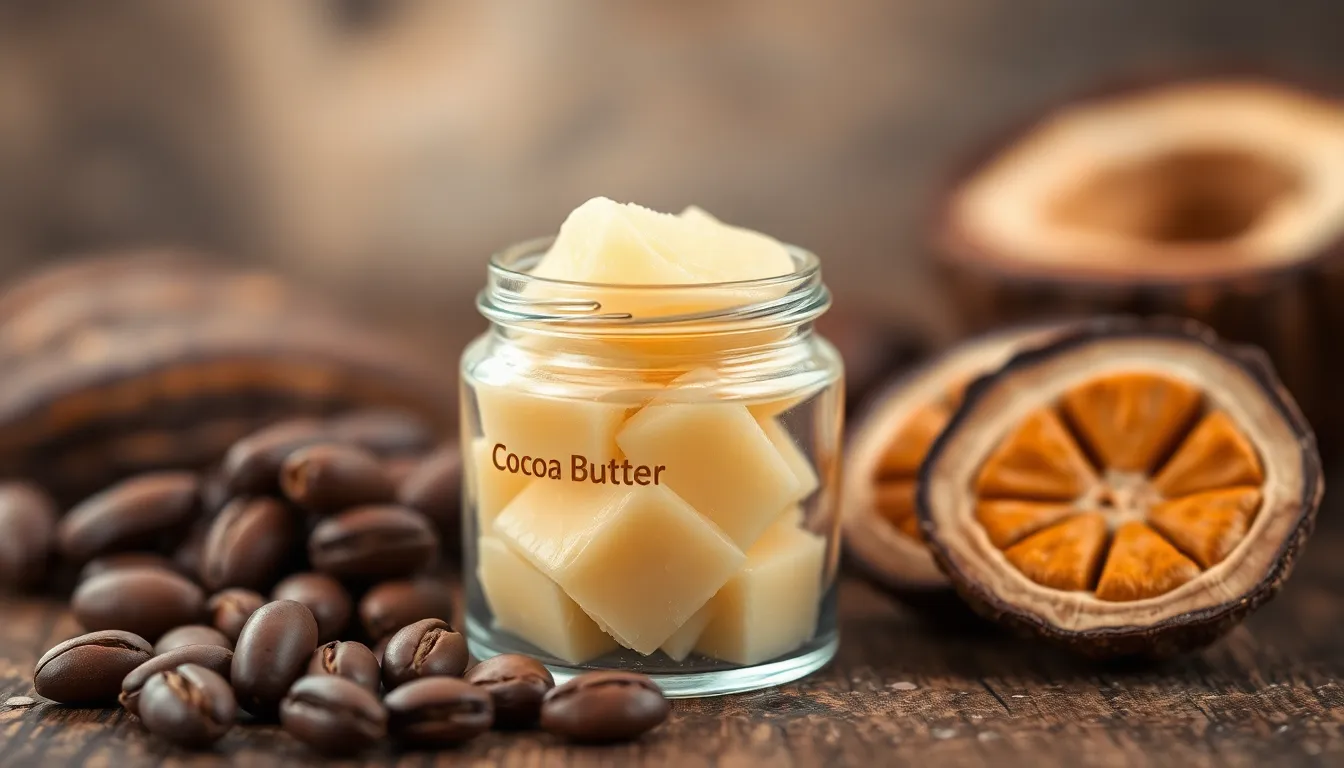Cocoa butter is the creamy, dreamy ingredient that turns ordinary products into luxurious treats. But what’s the secret behind this golden goodness? It’s not just a magical elixir from the chocolate fairies—it’s made from the fat extracted from cocoa beans. These beans undergo a process that transforms them into the smooth, velvety substance loved by chocolatiers and skincare enthusiasts alike.
Table of Contents
ToggleWhat Is Cocoa Butter Made Of
Cocoa butter consists primarily of fat extracted from cocoa beans. These beans undergo a careful process to transform into the silky substance used in a variety of products.
The Cocoa Bean
Cocoa beans originate from the cacao tree, Theobroma cacao. Each bean contains approximately 50 to 57 percent fat. Processing involves fermenting, drying, roasting, and grinding the beans to separate the fat from solids. During this process, the beans develop their rich flavor and aroma. A focus on quality ensures that only the finest beans yield high-quality cocoa butter.
Chemical Composition
Cocoa butter contains a mixture of fatty acids. The predominant types include oleic acid, stearic acid, and palmitic acid. Fatty acids contribute to its smooth texture and stable consistency. Its unique composition results in a melting point between 30 and 38 degrees Celsius. This property helps cocoa butter maintain its form at room temperature yet melt upon contact with skin or warm foods. This versatility makes cocoa butter ideal for use in chocolate and cosmetic products.
The Process of Extraction

The extraction process of cocoa butter is crucial for obtaining its rich, creamy essence. This process involves several key stages that enhance cocoa butter’s unique qualities.
Fermentation and Drying
Fermentation begins once cocoa beans are harvested. During this stage, beans undergo a natural fermentation process for about five to six days. This process develops the beans’ flavor profile and prepares them for drying. Sunlight or controlled drying methods reduce moisture content in the beans to around 7%. Proper drying ensures beans are ready for roasting, helping to preserve the desirable characteristics necessary for high-quality cocoa butter.
Pressing and Refining
After drying, roasting occurs, which further enhances the flavor. Roasted beans are then cracked to separate the nibs from the shells. Next, cocoa nibs are ground into a paste called chocolate liquor. This paste undergoes hydraulic pressing, which extracts cocoa butter while separating cocoa solids. Refining processes often follow, filtering the butter and removing any impurities. The final product is smooth and stable, ready for use in chocolates and cosmetics.
Nutritional Benefits
Cocoa butter offers several nutritional benefits due to its composition.
Fatty Acid Profile
Cocoa butter contains a unique fatty acid profile that includes oleic, stearic, and palmitic acids. Oleic acid constitutes about 38% of the total fat, providing heart-healthy properties. Stearic acid, making up nearly 34%, converts to oleic acid in the body, making it a neutral fat that doesn’t raise cholesterol levels. Palmitic acid, which accounts for approximately 25%, contributes to the skin’s moisture barrier. This combination of fatty acids helps promote skin health while offering energy sources for the body.
Antioxidants and Nutrients
Cocoa butter is rich in antioxidants, including polyphenols, which help combat oxidative stress. These compounds contribute to improved skin health and may reduce inflammation. Besides antioxidants, cocoa butter contains vitamins A, E, and K, essential for maintaining healthy skin and supporting the immune system. With its nourishing properties, cocoa butter aids in skin hydration and elasticity, making it a popular choice in skincare formulations.
Uses of Cocoa Butter
Cocoa butter serves as an essential ingredient in both food and cosmetic products due to its unique properties.
In Food Products
Cocoa butter plays a vital role in the chocolate industry, providing a smooth texture and rich flavor. Chocolatiers use it to stabilize chocolate formulations, enhancing mouthfeel and maintaining glossy finishes. It’s often blended with other ingredients to elevate the overall taste experience. Additionally, cocoa butter features prominently in baking, where it can replace traditional fats like butter or oils. Chefs appreciate it for its ability to solidify at room temperature while melting beautifully during consumption. Many health-conscious consumers favor products made with cocoa butter for its perceived health benefits and natural origins.
In Cosmetics
Cocoa butter excels in skincare formulations due to its deeply moisturizing properties. Many brands incorporate it into lotions, creams, and balms to enhance hydration and create a protective barrier against environmental stressors. The antioxidants in cocoa butter promote healthy skin, while vitamins A, E, and K support skin elasticity and nourishment. Consumers prefer it for its natural composition, making it suitable for a variety of skin types, including sensitive skin. Lip care products also frequently feature cocoa butter because it conditions and softens lips while providing a delectable scent. This versatility makes cocoa butter a favored ingredient among manufacturers and customers alike.
Cocoa butter stands out as a remarkable ingredient known for its rich flavor and moisturizing properties. Its unique composition of fatty acids and antioxidants not only enhances the quality of chocolate but also provides significant benefits in skincare products. The meticulous extraction process ensures that cocoa butter retains its luxurious texture and stability, making it a preferred choice for both chocolatiers and cosmetic formulators. With its versatility and health benefits, cocoa butter continues to be a staple in various industries, beloved by consumers for its nourishing qualities and indulgent experience.








